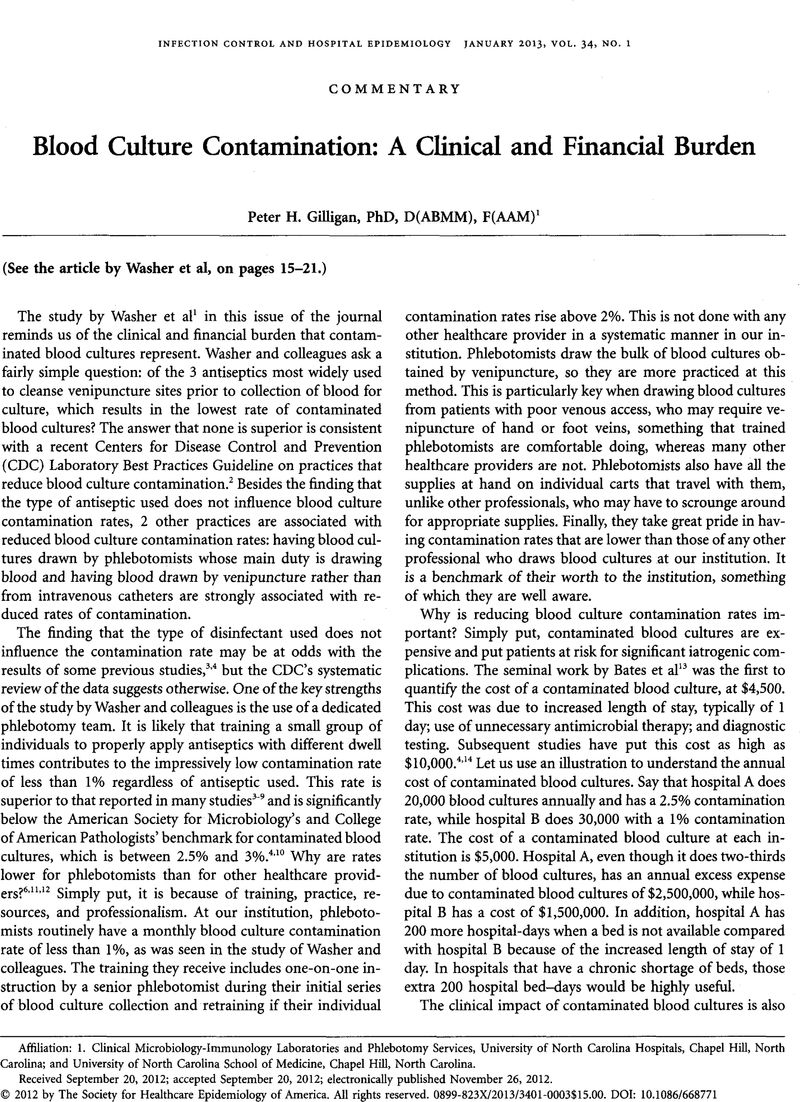Crossref Citations
This article has been cited by the following publications. This list is generated based on data provided by Crossref.
Miller, J. Michael
2013.
Cost-saving strategies for diagnostic microbiology laboratories.
Clinical Microbiology Newsletter,
Vol. 35,
Issue. 24,
p.
195.
2014.
ClinMicroNow.
p.
1.
2014.
ClinMicroNow.
p.
1.
Alnami, Abdulaziz Y.
Aljasser, Abdulrahman A.
Almousa, Raed M.
Torchyan, Armen A.
BinSaeed, Abdulaziz A.
Al-Hazmi, Ali M.
and
Somily, Ali M.
2015.
Rate of blood culture contamination in a teaching hospital: A single center study.
Journal of Taibah University Medical Sciences,
Vol. 10,
Issue. 4,
p.
432.
Manning, Mary Lou
and
Giannuzzi, Donna
2015.
Keeping Patients Safe.
JONA: The Journal of Nursing Administration,
Vol. 45,
Issue. 2,
p.
67.
Snyder, James W.
2015.
Blood Cultures: the Importance of Meeting Pre-Analytical Requirements in Reducing Contamination, Optimizing Sensitivity of Detection, and Clinical Relevance.
Clinical Microbiology Newsletter,
Vol. 37,
Issue. 7,
p.
53.
Kamboj, Mini
Blair, Rachel
Bell, Natalie
Son, Crystal
Huang, Yao-Ting
Dowling, Mary
Lipitz-Snyderman, Allison
Eagan, Janet
and
Sepkowitz, Kent
2015.
Use of Disinfection Cap to Reduce Central-Line–Associated Bloodstream Infection and Blood Culture Contamination Among Hematology–Oncology Patients.
Infection Control & Hospital Epidemiology,
Vol. 36,
Issue. 12,
p.
1401.
Garcia, Robert A.
Spitzer, Eric D.
Beaudry, Josephine
Beck, Cindy
Diblasi, Regina
Gilleeny-Blabac, Michelle
Haugaard, Carol
Heuschneider, Stacy
Kranz, Barbara P.
McLean, Karen
Morales, Katherine L.
Owens, Susan
Paciella, Mary E.
and
Torregrosa, Edwin
2015.
Multidisciplinary team review of best practices for collection and handling of blood cultures to determine effective interventions for increasing the yield of true-positive bacteremias, reducing contamination, and eliminating false-positive central line–associated bloodstream infections.
American Journal of Infection Control,
Vol. 43,
Issue. 11,
p.
1222.
Baron, Ellen Jo
2015.
Manual ofClinical Microbiology.
p.
270.
Lee, Guna
Lee, Yura
Chong, Yong Pil
Jang, Seongsoo
Kim, Mi Na
Kim, Jeong Hoon
Kim, Woo Sung
and
Lee, Jae-Ho
2016.
Blood Culture Testing via a Mobile App That Uses a Mobile Phone Camera: A Feasibility Study.
Journal of Medical Internet Research,
Vol. 18,
Issue. 10,
p.
e282.
2016.
Clinical Microbiology Procedures Handbook.
p.
3.4.1.1.
Tibbetts, Robert J.
and
Robinson-Dunn, Barbara
2017.
The Dark Art of Blood Cultures.
p.
183.
Ryan, Christina
2017.
Implementation of the Theory of Planned Behavior to Promote Compliance with a Chlorhexidine Gluconate Protocol.
Journal of the Association for Vascular Access,
Vol. 22,
Issue. 2,
p.
64.
Garcia, Robert A.
Spitzer, Eric D.
Kranz, Barbara
and
Barnes, Sue
2018.
A national survey of interventions and practices in the prevention of blood culture contamination and associated adverse health care events.
American Journal of Infection Control,
Vol. 46,
Issue. 5,
p.
571.
Corboy, Jacqueline B.
and
Attridge, Megan
2019.
Impact of Blood Culture Contamination on Patients and Health Care Systems: A Review of QI Strategies Within the ED.
Clinical Pediatric Emergency Medicine,
Vol. 20,
Issue. 3,
p.
100718.
Doern, Gary V.
Carroll, Karen C.
Diekema, Daniel J.
Garey, Kevin W.
Rupp, Mark E.
Weinstein, Melvin P.
and
Sexton, Daniel J.
2019.
Practical Guidance for Clinical Microbiology Laboratories: A Comprehensive Update on the Problem of Blood Culture Contamination and a Discussion of Methods for Addressing the Problem.
Clinical Microbiology Reviews,
Vol. 33,
Issue. 1,
Tsai, Chih-Min
Lin, Chun-Hung Richard
Zhang, Huan
Chiu, I-Min
Cheng, Chi-Yung
Yu, Hong-Ren
and
Huang, Ying-Hsien
2020.
Using Machine Learning to Predict Bacteremia in Febrile Children Presented to the Emergency Department.
Diagnostics,
Vol. 10,
Issue. 5,
p.
307.
Liaquat, Sidra
Baccaglini, Lorena
Haynatzki, Gleb
Medcalf, Sharon J.
and
Rupp, Mark E.
2021.
Clinical consequences of contaminated blood cultures in adult hospitalized patients at an institution utilizing a rapid blood-culture identification system.
Infection Control & Hospital Epidemiology,
Vol. 42,
Issue. 8,
p.
978.
Elvy, Juliet
Walker, Debra
Haremza, Elizabeth
Ryan, Katherine
and
Morris, Arthur J.
2021.
Blood culture quality assurance: what Australasian laboratories are measuring and opportunities for improvement.
Pathology,
Vol. 53,
Issue. 4,
p.
520.
Lungu, Olguta
Grigoras, Ioana
Dorneanu, Olivia Simona
Lunca, Catalina
Vremera, Teodora
Copacianu, Stefania Brandusa
Ivanov, Iuliu
and
Iancu, Luminita Smaranda
2021.
Indwelling Device-Associated Biofilms in Critically Ill Cancer Patients—Study Protocol.
Pathogens,
Vol. 10,
Issue. 3,
p.
306.



